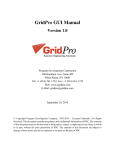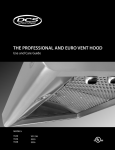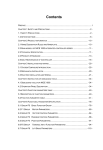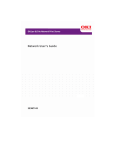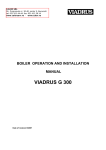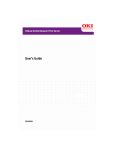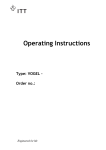Download Operating Instructions
Transcript
Operating Instructions VOGEL-Pit Pumps Design WTS EC-Manufacturers Declaration (only valid for pump) acc. to Machine Directive 2006/42/EG Appendix II B of European Parliament and Council of 17.05.2006. Manufacturer: ITT Austria GmbH A-2000 Stockerau, Ernst Vogel-Straße 2 Products: Pumps of model KST 1) 1) The mentioned products are intended for Installation into a machine / Assembly with other machines . Their putting into operation is forbidden so long, till it is proven, that the machine, in which the pump shall be integrated, corresponds with the regulations of the Machine Directive 2006/42/EG. Used harmonised norms, especially EN 809 EN ISO 12100 part 1 EN ISO 12100 part 2 Used national technical norms and specifications, especially DIN 31001 The Declaration of the Manufacturer expires, when the pump is installed into units, where no declaration of conformity, acc. to the Machine Directive 2006/42/EG, is existing. Stockerau, 25.05.2009 1) ................................................................................................ Robert Salzbauer Quality control Strike out what´s not the case EC-Declaration of Conformity on customer buyouts If essential components of the unit (e.g. motors) are provided by the customer and only the assembly of these components is made by ITT Austria, the whole conformity must be proved by the customer! EC- Declaration of Conformity (only valid for units completely delivered by ITT Austria) acc. to Machine Directive 2006/42/EG Appendix II A of European Parliament and Council of 17.05.2006. Manufacturer: ITT Austria GmbH A-2000 Stockerau, Ernst Vogel-Straße 2 Products: Pumps of model KST The mentioned products correspond with the regulations of the EC-Machine Directive 2006/42/EG. Used harmonised norms, especially EN 809 EN ISO 12100 part 1 EN ISO 12100 part 2 EN 60204 part 1 Used national technical norms and specifications, especially DIN 31001 For Declaration of Conformity of appliances and / or components (e.g. motors) used with the unit, refer to attachments. The Declaration of Conformity expires, when the pump is installed into units, where no Declaration of Conformity, acc. to Machine Directive 2006/42/EG, is existing. Stockerau, 25.05.2009 ................................................................................................ Robert Salzbauer Quality control Operating instructions Table of Contents 1. General ............................................................................................ page 3 1.1 Foreword 1.2 Guarantee 1.3 Safety regulations 1.4 Safety instructions Dangers of not following safety instructions Safety instructions for the operator Speed, Pressure, Temperature Protection against running dry Back flow 2. Description .........................................................................................page 6 2.1 Model Design 2.2 Permissible Temperatures 2.3 Bearings and Lubrication Design with Medium Lubricated Slide Bearings Design with Pure Water Lubricated Slide Bearings Design with Grease Lubricated Slide Bearings 2.4 Drive and Control Manual Switching Automatic Control 3. Transport, Handling, Storage ..........................................................page 9 3.1 Transport, Handling 3.2 Storage page 10 4. Assembly, Operation ............................................................................. 4.1 Preparing for Installation 4.2 Assembling and Installing the Pump 4.3 Connecting the Pipes to the Pump 4.4 Electrical connection 4.5 Starting up Lubrication the Slide Bearings Setting the Level Switch Initial Operations After Switching On Restarting 4.6 Operation and Monitoring Permissible Number of Operations 4.7 Shutting down 4.8 Dismantling 5. Maintenance, Servicing ................................................................... page 14 Storage Cleaning the pump page 14 6. Longer periods of non-operation .......................................................................... 7. Faults - Causes and Solutions ..........................................................page 14 WTS 102/3-en 1 Operating instructions 8. Repairs ...............................................................................................page 17 page 17 9. Spare Parts, Spare Pumps ................................................................. 9.1 Spare Parts Ordering Spare Parts 9.2 Stand-by Pumps 10. Plant Manager List .........................................................................page 19 11. Log Book ..........................................................................................page 20 Appendix WTS 102/3-en 2 Operating instructions 1. General 1.1 Foreword This product complies with the safety requirements of EC Machinery Directive 2006/42/EC. The staff employed on installation, operation, inspection and maintenance must be able to prove that they know about the relevant accident prevention regulations and that they are suitably qualified for this work. If staff do not have the relevant knowledge, they should be provided with suitable instruction. The operating safety of the pumps or units (i.e. pump plus motor) supplied is only guaranteed if these are used in accordance with the provisions given in the Confirmation of Order and/or Point 4 in „Installation and Operation“. The operator is responsible for following the instructions and complying with the safety requirements given in these Operating Instructions. Smooth operation of the pump or pump unit can only be achieved if installation and maintenance are carried out carefully in accordance with the rules generally applied in the field of engineering and electrical engineering. If not all the information can be found in these Operating Instructions, please contact us. The manufacturer takes no responsibility for the pump or pump unit if the Operating Instructions are not followed. These Operating Instructions should be kept in a safe place for future use. If this pump or pump unit is handed on to any third party, it is essential that these Operating Instructions and the operating conditions and working limits given in the Confirmation of Order are also passed on in full. These Operating Instructions do not take into account all design details and variants nor all the possible chance occurrences and events which might happen during installation, operation and maintenance. Alterations or changes to the machine are only permitted by agreement with the manufacturer. Original spare parts and accessories authorised by the manufacturer should be used for greater safety. We bear no responsibility for the consequences of using other parts. We retain all copyright in these Operating Instructions; they are intended only for personal use by the owner of the pump or the pump unit. The Operating Instructions contain technical instructions and drawings which may not, as a whole or in part, be reproduced, distributed or used in any unauthorised way for competitive purposes or passed on to others. 1.2 Guarantee The guarantee is given in accordance with our Conditions of Delivery and/or the confirmation of order. Repair work during the guarantee period may only be carried out by us, or subject to our written approval. Otherwise the guarantee ceases to apply. Longer-term guarantees basically only cover correct handling and use of the specified material. The guarantee shall not cover natural wear and tear and all parts subject to wear, such as impellers, shaft sealings, shafts, shaft sleeves, bearings, wear rings etc., or damage caused by transport or improper handling. WTS 102/3-en 3 Operating instructions In order for the guarantee to apply, it is essential that the pump or pump unit is used in accordance with the operating conditions given on the type plate and in the Confirmation of Order. This applies particularly for the endurance of the materials and smooth running of the pump and shaft sealing. If one or more aspects of the actual operating conditions are different, we should be asked to confirm in writing that the pump is suitable. 1.3 Safety regulations These Operating Instructions contain important instructions which must be followed when the pump is assembled and commissioned and during operating and maintenance. For this reason, these Operating Instructions must be read by the skilled staff responsible and/or by the operator of the plant before it is installed and commissioned, and they must be left permanently ready to hand at the place where the pump or pump unit is in use. The operator must ensure that the contents of the Operating Instructions are fully understood by the staff. The operator must confirm this by signing the „Plant Manager List“ (see Point 10). These Operating Instructions do not refer to the General Regulations on Accident Prevention or local safety and/or operating regulations. The operator is responsible for complying with these (if necessary by calling in additional installation staff). The safety instructions contained in these Operating Instructions have the following special safety markings as specified in DIN 4844: Warning against personal accidents which could occur if the safety instructions given in this part of the Operating Instructions are not followed. Warning against dangerous electrical voltage. Please note Warning against possible damage to property or the environment. It is absolutely essential that safety information affixed directly to the pump or pump unit is followed and maintained so that it is always easily legible. 1.4 Safety instructions Dangers of not following safety instructions Failure to follow the safety instructions can result in the following, for example: • People being at risk because of electrical, mechanical and chemical factors. • Important functions of the pump or pump unit failing. • Dangers to the environment as a result of dangerous substances leaking out. WTS 102/3-en 4 Operating instructions Safety instructions for the operator • Depending on the operating conditions, wear and tear, corrosion or age will limit the working life of the pump/pump unit, and its specified characteristics. The operator must ensure that regular inspection and maintenance are carried out so that all parts are replaced in good time which would otherwise endanger the safe operation of the system. If abnormal operation or any damage are observed, the pump must cease operation immediately. • If the breakdown or failure of any system or unit could lead to people being hurt or property being damaged, such system or unit must be provided with alarm devices and/or spare modules, and they should be tested regularly to ensure that they function properly. • If there is any risk of injury from hot or cold machine parts, these parts must be protected against contact by the user, or suitable warning signs must be affixed. • Contact protection on moving parts (e.g. coupling guards) must not be removed from systems that are in operation. • If dangerous media (e.g. explosive, toxic, hot) leak out (e.g. from shaft seals), these must be directed away so that there is no danger to people or the environment. The provisions of the law must be observed. • Measures should be taken to exclude any danger from electricity (e.g. by complying with the local regulations on electrical equipment). If work is carried out on live electrical components, they should be unplugged from the mains or the main switch turned off and fuse unscrewed. A motor protection switch is to be provided. • Basically, all work on the pump or pump unit should only be carried out when the pump is stationary and not under pressure. All parts must be allowed to return to ambient temperature. Make sure that no-one can start the motor during such work. It is essential that the procedure for stopping the system described in the Operating Instructions is observed. Pumps or pump systems that carry media that are dangerous to health must be decontaminated before being taken apart. Safety Data Sheets for the various liquids handled. Immediately the work has been completed, all safety and protective devices must be replaced or restarted. • Under EC Machinery Directives, every machine must be fitted with one or more emergency command devices by which situations which represent an immediate danger or which could later be dangerous can be avoided. This does not include machines in which the emergency switches cannot reduce the danger, either because they do not reduce the time required to stop the machine or because the do not allow the measures required by the danger to be taken. This emergency switch must: have controls that are clearly marked, easy to see and within easy reach; stop the dangerous movement as quickly as possible without causing any additional danger; trigger any specified safety movements or allow these to be started up. If the emergency command device is no longer operated after an emergency „off“ switch has been triggered, this must be maintained by blocking the emergency command device until it is released again. It should not be possible to block the device without this triggering an emergency „off“ switch. It should only be possible to release the device through an appropriate action; this release should not start the machine up again - it should only make it possible to start it up again. • If the power supply is interrupted or restored after being interrupted or if it is changed in any other way, this should not cause any danger (e.g. pressure surges). WTS 102/3-en 5 Operating instructions Speed, Pressure, Temperature Suitable safety measures must be taken at the plant to ensure that the speed, pressure and temperature of the pump do not exceed the limit values given. In addition, the pump must be protected against pressure surges such as can be caused by switching off the plant quickly (e.g. by non-return valve on the pressure side, flywheel, air vessel). Protection against running dry WTS-Pumps in Industrial design with mediumly lubricated slide bearings may not run dry under any circumstances as this could damage the bearings. If necessary provide for monitoring devices (e.g. Flow Switch for pure water lubrication) to ensure a continual flow of lubricant. Back flow There is no back stop for the pumping medium fitted in the pump itself. If flow back from the pressure line into the collecting shaft has to be avoided a suitable non-return valve or something similar should be attached to the pressure joints. 2. Description 2.1 Model Block-free non-chokable pump, rod design with drive above the shaft cover. Design Open vortex impeller therefore absolutely free flow through the pump casing. Shaft with two or more bearings, maintenance-free deep groove ball bearing on the drive side. Rod bearings with bronze bearing bushes and running sleeve of stainless steel. Bearing lubrication through the pumping medium (if pumping media are pure and non-abrasive) or alternatively through pure water or grease (if pumping medium is very dirty). Pressure pipe joints are drawn high by the covering plate. Please see the Appendix for the sectional drawings and index of parts as well as a scale drawing. The pump specification shows the characteristic curve, installation length, materials, lubrication type and motor output. Example of a Type Specification: 452 WTS 20 E 1104 Shaft pump: Model WTS, installation depth 1,900 mm, hydraulic data according to characteristic curve 5, industrial design with pure water lubricated sliding bearings, impeller rated diameter 20 cm, standard sealing, cast iron pump components, Motor 11 kW, 4-pole (approx. 1,450 min-1). WTS 102/3-en 6 Operating instructions Specification Diagram: 2 3 4 5 6 7 Installation depth 900 mm Installation depth 1400 mm Installation depth 1900 mm Installation depth 2400 mm Installation depth 2900 mm Installation depth 3400 mm 1 2 4 5 6 Characteristic curves 1 2 3 Standarddesign Industrial design, medium lubricated slide bearings Industrial design, pure water lubricated slide bearings Industrial design, grease lubricated slide bearings W T S 1 8 E N N S S V V 1 1 0 Code no for impeller, approx. diameter in cm Sealing with radial packing ring and gease chamber Cast iron Bronze Cast steel alloyed Motor power in 1/10 kW 4 Normal speed 1450 min-1 6 Normal speed 960 min-1 *) not required for normal cast iron model Characteristic curves: Capacity [m3/h] WTS 102/3-en 7 Operating instructions 2.2 Permissible Temperatures The values stated in the Confirmation of Order always apply. It is not permitted to exceed or go below these values. If no temperature is given in the Confirmation of Order the maximum permissible pumping medium temperature is 95° C. 2.3 Bearings and Lubrication The roller bearing situated above the shaft takes up the axial forces and radial forces which occur near the coupling. It is filled with grease for its life cycle and thus requires no maintenance. Depending on the installation length the pump has 1 (at an installation length of 1,900 mm or less) or 2 (at an installation length of more than 1,900 mm) slide bearings for guiding the shaft into the shaft area. Design with Medium Lubricated Slide Bearings • The pumping medium may not contain any abrasive elements. • Make sure that all slide bearings are flooded when the pump is switched on (at installation lengths of more than 1,900 mm also the upper rod bearing). • Otherwise no maintenance required. Design with Pure Water Lubricated Slide Bearings • During pump operations pure water must be fed to the slide bearings. If pumping media tend to conglutinate or leave deposits it may be necessary to leave the pure water supply switched on even when the pump is at a standstill. • On the upper surface of the base plate, a pure water connection with an R 1/4“ internal screw thread is provided for every sliding bearing. • Water consumption of approx. 1,5 litre/min at a pressure of 3 bar is to be expected per sliding bearing. Design with Grease Lubricated Slide Bearings • On the upper surface of the base plate a connection with an internal screw thread R 1/4“ is provided. 3 to 5 grammes of grease per day are required per bearing. We recommend grease with a consistency of NLGI grade 2. Always use grease with the same base. • The lubricating pipes are delivered filled with lithium soap grease. Please note The grease consumed enters the pumping medium. Take care that it does not pose an environmental hazard. 2.4 Drive and Control Driven by four or six pole vertical three phase induction motors. Manual Switching If no automatic control is provided the pump must be switched on and off by hand. WTS 102/3-en 8 Operating instructions Automatic Control • Automatic Operations can be attained by fitting a mercury level switch (e.g. Type NGE) or an electrode switch. • The switching device needed to turn the motor on and off (circuit breaker ,Y-∆-automatic circuit breaker) must be suitable for momentary contact control. • An alarm switch functioning independently of the mains can be fitted if desired. 3. Transport, Handling, Storage 3.1 Transport, Handling • Check the pump/pump unit immediately upon delivery/receipt of despatch for damage or missing parts. • The pump/pump unit must be transported carefully and by competent personnel. Avoid serious impacts. • Keep the pump/pump unit in the same position in which it was supplied from the factory. Take note of the instructions on the packaging. • The intake and discharge side of the pump must be closed with plugs during transport and storage. Please note Dispose of all packing materials in accordance with local regulations. • Lifting devices (e.g. fork-lift truck, crane, crane device, pulleys, sling ropes, etc.) must be sufficiently strong. The weight of the pump/pump unit is given in the Data Sheet. • The unit may only be lifted by the hooks provided (on the upper side of the base plate). The following illustration shows the correct method of carrying by crane. Please note Sling ropes must not be fixed to ends of shafts or the ring loops of the motor. Do not stand underneath suspended loads; take note of the general regulations on prevention of accidents. The pump/pump unit must be secured against tipping over and slipping until it has been fixed in its final location. WTS 102/3-en 9 Operating instructions 3.2 Storage Pumps or pump units that are stored for a long time before use must be protected against moisture, vibrations and dirt (e.g. by wrapping in oil paper or plastic sheeting). Pumps must basically be stored in a place where they are protected from the weather, e.g. under cover. During this time, all suction and discharge branches and all other intakes and outlets must be closed with dummy flanges or plugs. 4. Assembly, Operation 4.1 Preparing for Installation • Before installing the pump the opening in the shaft cover must be checked according to the dimensions contained in the Installation Diagram (No. M 473 in the Appendix). • The seat for the base plate (Position 380 in the sectional drawing) must be horizontal. • The shaft must be at least 100 mm deeper than the installation length of the pump (from the plate seat to the lower surface of the pump). 4.2 Assembling and Installing the Pump Please note Make sure that there is sufficient space for service and maintenance work to be carried out, especially for changing the drive motor or the whole pump unit. The motor ventilator must be able to take in sufficient cooling air. There must be at least 10 cm distance between the suction grid and a wall etc. Pumps with an installation length of more than 1,900 mm are delivered in two parts which must be fitted together as follows before being installed in the shaft. The part of the pump which has the lower rod mounted is laid on top of the shaft cover by means of pipe support clamps over the port. After the wooden wedges and fork have been removed the unit's drive part can be put in place. In addition, the shaft coupling 340 must be slipped onto the shaft 324/U, enabling the rod bearing screws or pressure pipe screws to be tightened. Then raise the shaft 324/U with the two screwdrivers by the two lower bore holes of the rod pipe 305/U lying opposite each other (see illustration), until the two shaft screws S4 can be screwed in the shaft groove provided through the two upper bore holes. Both shaft screws must be secured with either WTS 102/3-en 10 Operating instructions a screw locking liquid or a centre punch mark. Afterwards when the pipe support clamp has been removed, the pump can be lowered to plate 380 and after inserting the O-ring supplied (to seal against smell) screwed to the foundation frame. To seal against smell place the sealing discs supplied underneath the plate screw fitting (screw head or hexagon nut). 4.3 Connecting the Pipes to the Pump • When laying the pipes make sure that the pump is accessible for maintenance and assembly. • Connect pressure line with the nominal width 100 above the plate in such a way that the pump will not be subject to stress during operation due to pipe torque. • If pipes are to be connected with an elastic tension clamp the pipes must have an external diameter of 108 mm. • Before connecting to the pump: Remove protective coverings from the pump supports. • Before starting operations remove coarse impurities from the pump shaft. • When emptying the pipes and pump shaft make sure that the pump is suitably conserved (otherwise it can rust which will cause problems when operations are started). 4.4 Electrical connection The electrical connection work may only be carried out by an authorised professional. The rules and regulations valid for electrical technology, especially those concerned with safety measures, must be observed. The regulations of the national power supply companies operating in that area must also be observed. Details about electrical connections you can see in the operating instruction of the motor. 4.5 Starting up The plant may only be started up by people who are familiar with the local safety regulations and with these Operating Instructions (especially with the safety regulations and safety instructions given here). Lubricating the Slide Bearings • Pure water or grease for lubricating slide bearings must be supplied to the slide bearings before the pump is taken into operation for the first time, see Point 2.3 „Storage and Lubrication“. • If the lubricant supply is switched on and off automatically with the pump, lubricant must be applied to the slide bearings a few seconds before the pump is started. • Only switch off the pure water or grease supply after the pump has been turned off. • If there is danger of frost insulate the lubricant pipes or protect with an additional frost protection heating system. WTS 102/3-en 11 Operating instructions Setting the Level Switch Guide the cables of any level switches through the cable stuffing box of the switch cover 382/S and and clamp according to the desired switching levels. Initial Operations Remember that when starting against closed pressure line valves the power consumed by the pump is converted to heat and and discharged to the pumping medium. This can lead to impermissible warming of the pumping medium after a relatively short time which can damage the pump's inner fittings. Therefore after the pump has reached operating speed, the pressure side valve should be opened as quickly as possible. • Medium lubricated slide bearings must be flooded. • Start pure water or grease lubrication. • Check whether all safety devices are ready for operation. • Check the switch level setting (the lowest water level must guarantee sufficient water coverage). • Stay away from danger area containing live parts or parts under pressure. • Check direction of rotation by switching on and off briefly. It must be the same as the directional arrow on the bearing frame. To change the direction of rotation, see Point 4.4 „Electrical Connection“. If the direction of rotation is correct, the flow rate will increase and running will be quieter. • Start drive device. With manual Y/∆-switching, note information in Point 4.4 „Starting“. • Οpen any slide valves present in the pressure line. • Work on the pump may only be carried out when the current has been switched off and the movable parts are no longer turning. Switching on by unauthorized persons is to be prevented by appropriate measures. • In case of failure, e.g. motor does not start, fuses blow or the motor protection switch is activated immediately, on no account should you repeat the starting procedure (danger of excess pressure in motor due to impermissible warming). Detect cause of fault and repair. After Switching On • Τhe direction of rotation can also be checked after switching on. This is done by comparing the flow rate and running noise of the pump. To change the direction of rotation, see Point 4.3. If the direction of rotation is correct, the flow rate will increase and running will be quieter. • Check current uptake and running of machine. • If faults occur, see chapter 7 „Faults - Detection and Repair“. Restarting Basically, the same procedure should be followed as for starting up for the first time. However, there is no need to check the direction of rotation of the pump unit. 4.6 Operation and Monitoring Be particularly careful not to touch hot machine parts. Remember that automatically controlled systems may switch themselves on suddenly at any time. Suitable warning signs should be affixed. WTS 102/3-en 12 Operating instructions Please note Regular monitoring and maintenance will extend the life of your pump or pump system. • You must observe the area of application given in the Confirmation of Order. • Do not exceed the output given on the motor rating plate. • Running dry, running against a closed pressure side valve or operating in the steam phase of the pumping medium are to be avoided at all costs. • Avoid sudden changes in temperature (temperature shocks). • The pump and the drive machine should run evenly and with no vibrations, check at least once a week. • Check functioning of the lubricant supply. • When operating on automatic control: Check that switching functions are working properly. if using pure water or grease lubrication leave the lubricant supply switched on during standstill times unless the supply is automatically switched on or off with the pump (see Point 4.5 „Starting up“). • Pumps which are exposed to corrosive chemicals or to wear through abrasion must be inspected periodically for corrosion or wear and tear. The first inspection should be carried out after six months. All further inspection intervals should be determined on the basis of the state of the pump. Permissible Number of Operations At a motor output up to and including 7,5 kW a maximum of 40, at higher output a maximum of 20 starts per hour are permitted. 4.7 Shutting down • Close slide valve in discharge pipe. This is not necessary if there is a spring-loaded non-return valve. • Switch of motor (make sure it runs down quietly). • Switch off the pure water or grease lubricant unless a continuous supply of lubricant is necessary due to the nature of the pumping medium (e.g. sticky) or the pump is being operated on automatic control. • If there is any danger of freezing, empty pump and pipes completely. 4.8 Dismantling The operator's or manufacturer's fitters should be informed as to the nature of the liquid handled. In the case of pumps handling dangerous liquids, the liquid handled should be disposed of by environmentally acceptable means before the pump is dismantled. • Before starting to disassemble the pump unit make sure that it cannot be switched on again. • Pressure line shut-off must be closed. • All components must have cooled down to ambient temperature. • Before dismantling the pressure line make sure that it is empty and depressurised. • When the pump has been dismantled: Secure the opening of the shaft. WTS 102/3-en 13 Operating instructions 5. Maintenance, Servicing Work should only be carried out on the pump or pump unit when it is not in operation. You must observe Point 1.4 „Safety instructions“. Please note Maintenance and servicing work must only be carried out by trained, experienced staff who are familiar with the contents of these Operating Instructions, or by the Manufacturer's own service staff. The work carried out must be duly entered in the „Log Book“ (see Point 11) and confirmed by being signed. Storage • After 4 years renew the deep groove ball bearings (K) as the grease ages and loses its lubricity. • After an average of 5 years the grease in the motor bearings has aged so much that we recommend that you change the bearings. Cleaning the pump Dirt on the outside of the pump reduces heat discharge. Therefore the parts of the pump above the base plate must be cleaned with water at regular intervals (depending on how dirty they are). Please note The pump should not be cleaned with pressurised water - water will get into the bearings. 6. Longer periods of non-operation Please note When starting up, follow the instructions for starting up for the first time (see Point 4.5)! • Turn the pump shaft by hand at least 1x week before starting operations again. This can take place at the motor ventilator but you must make absolutely sure that the motor cannot be switched on either automatically or manually during the examination. • If the lubrication of the slide bearings is guaranteed: Switch the pump on and then off again immediately. • After 4 years renew the pump's deep groove ball bearing (K) and the motor bearing as the grease ages and loses its lubricity. • After an average of 5 years the grease in the motor bearings has aged so much that we recommend that you change the bearings. 7. Faults - Causes and Solutions The following notes on causes of faults and how to repair them are intended as an aid to recognising the problem. The manufacturer's Customer Service Department is available to help repair faults that the operator cannot or does not want to repair. If the operator repairs or changes the pump, the design data on the Data Sheet and Points 1.2-1.4 of these Operating Instructions WTS 102/3-en 14 Operating instructions should be particularly taken into account. If necessary, the written agreement of the manufacturer must be obtained. Faults Discharge too low Discharge stops after a time Head too low Head too high Drive mechanism overloaded Pump not running quietly Temperature in the pump too high Temperature at the bearing too high Code no. for cause and method of repair 1, 4, 6, 7, 8, 9, 10, 11, 12, 13, 14 8, 10, 11, 21 2, 4, 6, 7, 8, 9, 10, 11, 12, 13, 14, 21, 24 3, 5, 24 2, 3, 5, 14, 17, 19 7, 10, 13, 15, 16, 17, 20, 21, 23 7, 10, 21 2, 3, 16, 17, 18, 20, 22 Meaning of code number for cause and method of repair 1. Back-pressure too high • open discharge valve further • reduce resistance in discharge pipe (e.g. clean filter if necessary) • use larger impeller (note available motor power) 2. Back-pressure too low, discharge too low • throttle discharge valve 3. Speed too high • reduce speed • compare speed of motor with specified pump speed (rating plate) • when adjusting speed (frequency transformer) check reference value setting 4. Speed too low • increase speed (check available motor power) • compare speed of motor with specified pump speed (rating plate) • when adjusting speed (frequency transformer) check reference value settings 5. Impeller diameter too large • use smaller impeller 6. Impeller diameter too small • use larger impeller (check available motor power) 7. Pump and/or pipes not completely filled with liquid • fill • vent 8. Pump blocked • clean WTS 102/3-en 15 Operating instructions 9. Air pocket in pipeline • vent • improve course of pipe 10. NPSH of system too small increase liquid level 11. Air being sucked in • increase liquid level 12. Direction of rotation is wrong • swap over two phases of power supply (to be done by a specialist electrician) 13. Inner components suffering from wear • replace worn parts 14. Density and/or viscosity of liquid handled is too high • seek assistance 15. Impeller out of balance • remove blocks/deposits • replace if broken or unevenly worn • check shafts to ensure that they are running true 16. Coupling distance too small • change 17. Forces in pipeline too high (pump unit under strain) change (support pipes, use compensators, etc.) 18. Too much, too little or the wrong type of lubricant • change 19. Electricity supply not right • check voltage of all phases (2-phase running) • check cable connections • check fuses 20. Bearing damaged • replace • check lubricant and bearing space for pollutants (rinse oil area) 21. Discharge too small • increase minimum amount carried (open slide valves, bypass) WTS 102/3-en 16 Operating instructions 22. Discharge too high • reduce amount carried (throttle slide valve) 23. System-related vibrations (resonance) • seek assistance 24. Manometer indicator wrong • check manometer • get rid of blockages • put manometer in suitable place (no flow distortion or burbling) 8. Repairs Repairs to the pump or pump system may only be carried out by authorised skilled personnel or by the manufacturer's specialist staff. We would be pleased to send you detailed repair instructions on request. Trained Customer Service engineers are available to assist with installation and repair work on request. When removing the pump or the motor, you must comply with Point 1.4 „Safety instructions“, Point 3.1 „Transport, Handling“ and Point 4.8 „Dismantling“. 9. Spare Parts, Spare Pumps 9.1 Spare Parts Spare parts should be selected to last for two-years continuous operation. If no other guidelines are applicable, we recommend that you stock the number of parts listed below (in accordance with VDMA 24296). Number of Pumps (incl. Stand-by Pumps) Spare Part impeller shaft with key and shaft screws/nuts sets bearing joints for pump casing other joints sets drive unit, completed Elastic coupling elements Sätze WTS 102/3-en 2 3 1 1 1 4 4 1 1 1 1 6 6 1 4 5 6/7 Number of Sare Parts 1 2 2 2 2 2 2 2 3 8 8 9 8 8 9 2 2 2 8/9 10/more 3 3 4 12 10 1 3 30% 30% 50% 150% 100% 2 30% 17 Operating instructions Please note To ensure optimum availability, we recommend that suitable quantities of spare parts are held in stock, especially if these are made from special materials and in the case of mechanical seals, because of the longer delivery times. Ordering Spare Parts When ordering spare parts, please supply the following information: • Type: ________________________ Order no.: ________________________________ • Part designation ______________________ in sectional drawing ________________________ All the information is given on the relevant sectional drawing. 9.2 Stand-by Pumps It is essential that a sufficient number of stand-by pumps are kept ready for use in plants where failure of a pump could endanger human life or cause damage to property or high costs. Regular checks should be carried out to ensure that such pumps are always ready for use (see Point 6.2). WTS 102/3-en 18 Operating instructions 10. Plant Manager List Each plant manager should sign below to confirm that he has received, read and understood these Operating Instructions. He undertakes to follow the instructions conscientiously. If these instructions are not followed, the manufacturer's guarantee and liability shall cease to apply. Name: Date: Signature: WTS 102/3-en 19 Operating instructions 11. Log Book Each plant operator shall duly enter all maintenance and service work that has been carried out, and shall see that the person responsible confirms such work by signing below. Maintenance work: Date: Signature Confirmed by Plant operator person responsible: WTS 102/3-en 20 Pumpenfabrik ERNST VOGEL GmbH Ernst Vogel-Straße 2 A-2000 Stockerau Telefon: (+43) 2266 / 604 Fax: (+43) 2266 / 65311 E-Mail: [email protected] Internet: www.vogel-pumpen.com www.hydrovar.com


























